You want to go horseback riding in Kyrgyzstan and are looking for as much information as possible to prepare your trek?
Since the publication of my guide to Kyrgyzstan, I've often exchanged views on horse trekking with my readers. Thanks to these exchanges, to the advice of my local friends and to my experience in the field, I've put together here the best recommendations for you to be well prepared.
This guide answers all your questions:
-
Where can I find a reliable horse?
-
How do you check if your horse is in good health? What to do if he hurts himself?
-
What are the basics of trekking horseback riding?
-
What's a typical day on horseback in Kirghizia like?
-
What equipment do you need for your hike?
-
Who should you contact to organize a trek with complete peace of mind?
Here you'll find all the answers to the questions my friends, readers and I asked ourselves before our first trip.
Join the community!
To exchange ideas with other travelers, join the Facebook group " Voyager au Kirghizistan" . Created in June 2018, it's the ideal place to share the latest info, good tips and find fellow travelers. Don't hesitate to contribute to keep the community alive!
My trusted contacts for a successful tour
To leave serenely, I share with you the contacts of Tatosh and Azamat, experienced local guides to whom I have already referred hundreds of readers since 2015:
-
Tatosh Tatosh: specialist in tourist treks, perfect for beginner riders.
-
Azamat Azamat: expert in off-the-beaten-track expeditions for experienced riders and adventurers.
Bonus: a self-guided adventure
As a bonus, discover the story of Florent, who chose to buy his own horse to explore Kyrgyzstan in total autonomy.
Contents
- 1 Why travel on horseback?
- 2 Who is it for?
- 2.1 Do I need to know how to ride?
- 2.2 What are the basics of horse riding?
- 2.3 What should I check before I start my trek?
- 2.4 How do I check my horse for injuries?
- 2.5 What should I do if my horse is injured on the road?
- 2.6 Should I take a packhorse?
- 2.7 Is wearing a riding helmet really important?
- 2.8 Do I need to be insured?
- 2.9 How much does horseback riding cost?
- 2.10 When to go horseback riding in Kirghizia?
- 3 Where to go on a horse trek in Kyrgyzstan?
- 4 What treks do you recommend for experienced riders?
- 5 Do I need a guide, and under what conditions?
- 5.1 Can I rent a horse?
- 5.2 What are the conditions for renting Fidel, Tian or Chai?
- 5.3 Can I buy a horse?
- 5.4 How is the accommodation?
- 5.5 How do you wash and go to the toilet?
- 5.6 What kind of clothes should I bring?
- 5.7 Can I recharge my electronic devices?
- 5.8 Do you have any guides to recommend?
- 5.9 What's a typical day on the trail?
- 6 What should I pack for a trek on horseback?
- 7 What is the place of horses in Kyrgyz culture?
- 8 Do you have any feedback from people who have traveled alone on horseback?
- 8.1 Hi Florent, can you introduce yourself?
- 8.2 Why did you choose Kyrgyzstan for your solo horseback trip?
- 8.3 You have already traveled on horseback in Mongolia. How was this trip to Kyrgyzstan different?
- 8.4 What level of riding experience is required to attempt this adventure?
- 8.5 How did you manage to buy your horse, and how much did you pay for it?
- 8.6 How did you feed, water, and care for Saphir?
- 8.7 How do you ensure your horse is healthy?
- 8.8 What was your typical day like?
- 8.9 What route did you take? How did you find your way?
- 8.10 Has the horse changed your relationship with the locals?
- 8.11 What do you see as the risks of traveling alone on horseback? How can they be avoided?
- 8.12 Finally, Florent, can you share your fondest memory with us?
- 9 Conclusion
Why travel on horseback?
Kyrgyzstan is a land of nomads, who travel through the mountains on horseback, setting up their yurt camps as the seasons change. Horses are an integral part of their life and culture.
On your treks, you'll often meet real nomads, seasoned riders who cross these mountains.
Your equine companion will give you a unique feeling of freedom.
-
You'll be able to gallop among a horde of free-roaming horses.
-
In the evening, a nomad family will welcome you and teach you to play their traditional instrument.
-
You'll even learn how to milk mares, to make their famous fermented alcohol.
Horseback riding is one of one of the best reasons to travel to Kyrgyzstan.
Who is it for?
For anyone who wants to. I've met riders of all ages and backgrounds.
Among my most memorable encounters:
A French family with three children and their parents. They were traveling with :
-
A guide to accompany them.
-
Four horses for the five members of the family.
-
The youngest children (aged 4 and 6) rode with one of their parents, seated at the front.
I was lucky enough to share a bit of the road with them after their four-day hike.
Choosing the right band
Here's my best advice:
-
Share your trek with riders of equivalent level to avoid differences in pace.
-
If levels differ too much, a second guide will enable the group to split up easily.
Do I need to know how to ride?
No, before you start your trek your guide will give you a full riding course.
What are the basics of horse riding?
To keep things simple, here are the main rules:
-
Never walk behind your horse.
-
Always carry a bomb for safety.
-
Use your reins to steer your horse.
-
To move forward: strike with your heels, saying TCHU TCHU.
-
To slow down: pull on the reins and say BRE BRE.
-
To turn: turn your reins to the desired side.
-
When climbing: lean forward to help your mount.
-
Downhill: lean back.
-
To back off: pull firmly on the reins.
-
High shoes are mandatory: they protect against stirrup injuries.
-
Put pressure on your feet and lower your heels to avoid getting stuck in the stirrups.
I also made this video for you at Sary Chelek:
I invite you to read this article explaining how to ride a horse.
Contrary to what some people think, horseback riding is quite physical. At the end of the day, expect to be tired and sore. Make sure you' re properly equipped to avoid chafing and possible pain in the buttocks and thighs.
What should I check before I start my trek?
Before you leave, make sure your horse is in good health. Some travelers have told me about their misadventures with injured horses.
Injured horses should never be offered to travellers. If your guide insists, refuse outright and ask for another horse.
This is a simple rule to apply everywhere, whatever the country or guide. If no one accepts to ride an injured horse, the organizers will be obliged to ensure that they are in good condition.
How do I check my horse for injuries?
Before riding, check the condition of your horse to avoid any unpleasant surprises. The most sensitive area is the girth, where the saddle rests. Take a good look at this area to make sure there are no sores, chafing or swelling.
In Kyrgyzstan, equipment does not always meet European standards. It's not uncommon to see a saddle strap made from a car seatbelt. The material is not always perfect, but a simple fleece protection on the strap is enough to avoid many injuries.
The same goes for shoeing: a complete shoeing job costs 500 som and takes about a month and a half. An owner who regularly rents out his horse should always have it properly shod.
If you book with Tatosh (my friend who organizes rides in Song Kul), be aware that she is already making the farmers aware of these points. If you are presented with an injured horse, refuse it immediately and let us know.
What should I do if my horse is injured on the road?
Even with every precaution, your horse can injure himself along the way. If you notice lameness, a cut or irritation in the saddle, here's what to do:
- Stop immediately to examine the animal.
- Report the problem to your guide and insist that he take the situation seriously.
- If the horse is in pain, don't continue. Get down and walk beside him.
- Ask for a change of horse if possible, especially if you're on an organized trek.
- If you are alone, find a place where your horse can rest and assess the severity of the injury before continuing.
If it is a recommended guide on the blog, let me know.
Should I take a packhorse?

It depends on the weight of your belongings. A horse should carry no more than 25-30% of its own weight. If your load exceeds this limit, a pack horse is essential.
When can you do without it?
For short, light treks(e.g. Song Kul), you don't need a pack horse.
- It's a loop: you sleep in a yurt and meals are prepared by the nomads.
- Your belongings stay in the departure village, and you pick them up on your return.
- You travel light, so one horse is enough.
When do you need one?
A pack horse is requiredfor a long, self-sufficient trek.
- If you're carrying food and camping gear, only one horse will be overloaded.
- An extra horse can lighten your main mount and ensure a more comfortable trek.
Is wearing a riding helmet really important?
Yes, horseback riding is a risky sport, even as a leisure activity. A fall can happen at any time. It's best to let your helmet take the impact, not your head.
In the mountains, far from hospitals, an accident can quickly become a real problem.
As of 2019, the guides I recommend in Song Kul provide Decathlon riding helmets, brought from France by blog readers and myself (thanks to them!).
In 2021, I spoke to the French ambassador in Bishkek about this subject.
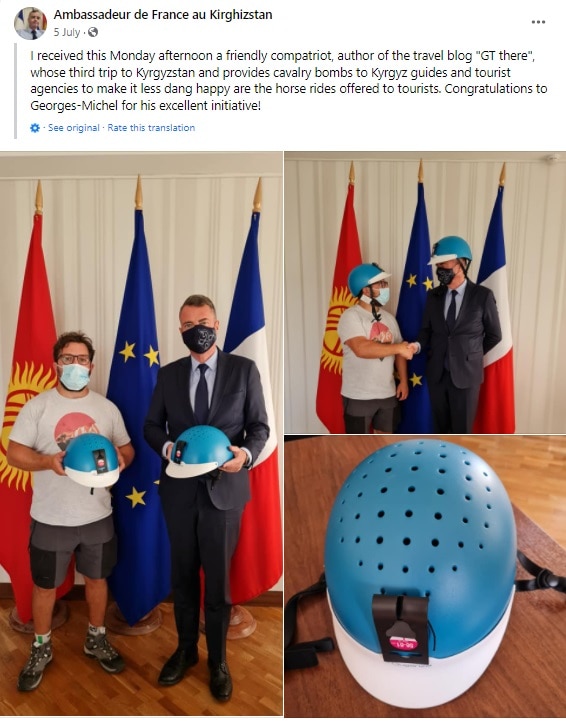
Do I need to take out insurance?
Yes, and don't take it lightly. As with any trip, insurance is essential. Riding is a high-risk activity, and an accident can quickly turn your adventure into a nightmare.
Travelling without insurance is stupid. If something goes wrong, medical and evacuation costs can be astronomical. Don't take that risk.
How much does it cost to ride a horse?
The price of a horseback ride depends on several factors. The larger your group, the lower the price, as you share the cost of the guide and logistics.
- An English-speaking guide costs a little more, a French-speaking guide a lot more.
For longer hikes, rates are negotiated according to group size and logistical requirements.
Why do some treks cost more?
Duration and experience of the guide
-
- The longer the trek, the more it requires an experienced guide, which increases the price.
Heavier logistics
-
- Camping equipment for nights away from the yurt camps.
- Kitchen equipment also on hire.
Transport of equipment and catering
Depending on the size of the group, you will need :
-
- One or more pack horses to carry the equipment.
- One or more grooms to manage the horses and set up and dismantle the camps.
- A cook to prepare meals and manage supplies.
Alternatives with a 4×4
Some agencies offer a 4×4 to return to the camp each evening with the luggage and cook.
Disadvantages: it's neither ecological nor economical, and it breaks the spirit of a real horseback adventure.
When is the best time to go horseback riding in Kyrgyzstan?
If you want to ride in the best conditions, aim for the period from May to September.
- July and August are the hottest, but also the busiest. But don't worry, even in summer, the crowds remain reasonable.
- In Song Kul, you can hike all year round, but winter is harsh: between -10°C and -20°C. Yurts are still set up to welcome travelers, but it's best to be well equipped for the cold.
Where to go on a horse trek in Kyrgyzstan?
Kyrgyzstan offers many incredible spots for horseback riding.
Most popular destinations :
These are the most accessible and offer the most affordable treks:
- Song Kul: The country's most famous lake, perched at an altitude of 3013 m, is surrounded by mountains. There are several routes to reach it, from 1 to 4 days' trekking. Yurts are available along the way to welcome you.
- Issy KulIssy Kul: Second largest alpine lake in the world after Titicaca, this salt lake at an altitude of 1,600 m is home to a number of agencies offering treks at reasonable prices.
Other places for exceptional horseback riding:
- Sary Chelek National Reserve
- An idyllic setting with lakes surrounded by walnut and conifer forests.
- Alay (south of the country): A completely different panorama with glaciers, rocky mountains and pine-covered gorges. In the distance, you'll see Mount Lenin (7134 m).
- Karakol region: Access to the Terskey Ala-Too mountain range (up to 5100 m altitude). Experienced riders can cross passes at over 3800 m.
- Chong Kemin (north of Issyk Kul): Perfect terrain for galloping through pine forests and vast pastures.
- Arslanbob: The world's largest walnut forest, offering spectacular scenery. No yurts here, as the nomads have settled down and live in huts.
For a longer adventure
If you have the time and budgetyou can combine several of these regions to make longer tours.
What treks do you recommend for experienced riders?
My buddy Azamat offers several off-the-beaten-track treks, perfect if you're a seasoned rider in search of adventure.
My two favourites are located in spectacular regions:
- Toktogul region: A fast-paced, more adventurous trek, ideal if you like endurance and technical terrain.
- Tien Shan Mountains: A more accessible itinerary, offering a balanced pace and grandiose panoramas.
Trekking in the Toktogul region.
This trek is my favorite. I did it in 2021 with my friends Basile and Loïc. It's a unique adventure. You're unlikely to come across any other travelers. Days on horseback last between 5 and 8 hours, and nights are spent in tents or with local people. This trek is as intense as it is magnificent. You'll discover landscapes of incredible diversity, experience total immersion in the culture of the Kyrgyz horsemen and benefit from the experience of passionate local guides. Nurlan, the local ranger, is guiding this expedition. He knows these mountains like the back of his hand. Today, he's become a friend, and every year I visit him and his family. If you're dreaming of a great trek on horseback through spectacular scenery, this is the one for you. Head for the Tien Shan mountains, not far from Lake Issyk Kul, for an unforgettable adventure. You'll spend 5 to 7 hours a day on horseback, with nights in tents and a final stop at a yurt camp on the shores of Lake Issyk Kul. Every year, many travellers follow this itinerary and return enthusiastically. Yes, a guide is indispensable. A horse isn't just a means of transport, it's a living being that needs care, food and rest. Our guides know their horses inside out, and know how to anticipate their needs. The Kyrgyz have a technique all their own: at night, they leave the horses semi-liberty, simply tied by the forelegs, so that they can graze and drink. I wanted to try it on my own. I rented a horse from a farmer and set off without a guide. I'm a good rider, but I wasn't totally serene. Just to take a break in the middle of nowhere, I wondered if my horse would take advantage of the opportunity to run away... and if I'd have to look for him alone in this immense mountain. Yes, and it's a great opportunity if you want to go off on your own with your mount! Since 2022, Hélène has been renting 3 specially selected Kyrgyz horses to riders who want to experience a trek in total freedom. Hélène is a real enthusiast. She has been breeding horses in Kyrgyzstan for over 20 years. She bought Fidel, Chai and Thian from Ashley and Quentin, two adventurers who traveled 1600 km across the country on horseback in 2021. These horses are experienced and well-trained. They are geldings, which is very rare in Kirghizia, and allows you to cross herds without stress. Many of you have asked me the question: can you rent a horse? After lengthy discussions with Hélène, she came up with a unique and intelligent concept, perfectly aligned with our values. Renting a horse from Hélène means leaving on your own while benefiting from : To leave with one of her horses, Hélène will ask you : Prices include the horse, its equipment and training for a safe departure: You can reach her by email at helene.kirghizie@gmail.com Yes, it's possible, but it's better to know what you're getting into. If you want to buy a horse, go to the animal market in Karakol or Tokmok, every Sunday morning. It's a unique experience: horses, cows, sheep... everything is traded in an authentic atmosphere. A horse is worth between $1,000 and $1,500, but price isn't everything. Are you sure you can take care of it? A horse is much more than just a means of transport. You'll need feed, care for and water it... and make sure it's healthy. Yurts are large and spacious. Most of the time, host families have one yurt for travelers and another for themselves. Inside, you'll find simple mattresses and warm blankets. All travelers sleep in the same yurt, which keeps the heat in on those chilly Kyrgyz mountain nights. Outside the yurt camps, you're on your own. Toilets in the camps are rudimentary: a simple hut a little out of the way, with a hole dug in the ground. No comfort, but it does the job. As for showers, some camps offer a cabin with a supply of cold water. Otherwise, you have the option of an icy river... but you need to be motivated. Let's be honest, most travelers just change their clothes...and wait patiently for the return to town for a good shower. In summer, it's very hot during the day, but the nights are freezing. Take warm, covering clothes to keep out the cold once the sun goes down. The weather changes quickly, so take rain gear to avoid unpleasant surprises. Finally, make sure your clothes are suitable for riding, to avoid chafing and unnecessary pain. Wear high shoes or boots to protect your ankles from the stirrups and avoid injury. Yes, as long as you have an external battery. Yurt camps have no electricity, apart from a small solar battery. This enables nomads to power a light bulb or a satellite phone, but it' s impossible to plug in your appliances. Manage your autonomy and use your devices sparingly, to avoid running out of power. Yes, and if you want to leave with peace of mind, I have two guide friends to recommend you. They're experienced, passionate about their country and horses, and I trust them completely. Since 2015, I've sent hundreds of readers to them, and they've all come back delighted. Tatosh is a Kyrgyz friend who I've known since the blog was created. Every year, I send her travelers, and she has never disappointed me. I recommend Tatosh, to organize your fabulous trek to Lake Song Kul. Azamat is a very good friend of mine, and on every trip I stay with him. In 2021, I was even lucky enough to welcome him to France to show him Paris and Fontainebleau, his first trip outside Kyrgyzstan. Azamat We're not the only ones: every year, readers of the blog go away with him... and they all come back conquered! Azamat is the ideal guide to organise a hand picked horseback ride for you. On a horseback trek, you don't ride all day. Stages last between 3 and 6 hours, depending on the day. Most of the time, you're at a walk. A horse can't gallop for 3 hours at a time. Your day starts early, with a hearty breakfast in the yurt or out in the open, watching the sun rise over the deserted mountains. Once your belly is full, you help your guide prepare the horses, and off you go on your adventure. Depending on the itinerary, you can : When you arrive, a family of Kyrgyz herders (5 to 10 people) welcomes you. Their main activity is herding, but they also welcome travelers. Camp is a bit like staying on a farm in France, except that your hosts rarely speak English. While the horses are resting, you can : Dinner is served in a yurt, around a low table, with traditional dishes. You eat sitting on the floor, Kyrgyz-style. Then you're assigned a yurt for the night, which you share with your group. The farmers provide warm blankets for a comfortable night's sleep. Night falls quickly, and even if you're tired, take the time to admire the sky. Far from light pollution, the spectacle is incredible. Probably one of the most beautiful starry skies you'll ever see. Go to the bathroom before you go to bed. It's freezing cold at night, and you won't want to leave the yurt. After a good night's sleep, you'll be back on horseback, ready for another day of adventure. In Kyrgyzstan, even in the middle of summer, the mountains can hold surprises in store for you. The weather changes rapidly, and you can experience all 4 seasons in one day. So pack clothes for hot, cold and rain. When choosing your clothes, make sure they're suitable for riding. The aim is to avoid chafing and pain. To equip yourself like a true Kirghiz, go to the Bishkek bazaar. Buy Kok Boru chaps (600 soms) and a rain cape (500 soms) from this merchant. To help you find her, in addition to her photo, I'm leaving you her GPS coordinates. She doesn't know me, but don't hesitate to say hello for me! Mountain streams are often contaminated by animal faeces. Purify water before drinking. The riding bomb: Essential. Let me explain it through Hippo. He is a foal born in May 2024, on the pastures of Song-Kul. His father, Mustang, is a champion Kök Börü stallion. In November, my friend Beksultan gave him to me as a gift. Kyrgyzstan is a country of mountains andtranshumance. For centuries, horses have been essential to everyday life. travel long distances, keep and move herds, hunt and defend oneself move between valleys and summer pastures. Even today, in remote areas, the horse remains essential. Here, horses are not a leisure activity. They are working companions. In Kyrgyz culture, the horse is considered an extension of the rider’s body. Mares are not ridden and do not have individual names. reproduction milk production Mare’s milk is used to produce koumis, a traditional fermented drink. In Song-Kul, you can try it at the yurt camps, including Hippo’s mother’s camp. In Kyrgyzstan, a specific word is used depending on the age and stage of development of the horse: Kulun (Кулун): from birth to 1 year old, suckling foal Jabagı (Жабагы): around 1 year old, weaned foal Tay (Тай): 2 years old, young horse not yet ridden. Hippo is currently a Tay Kunan (Кунан): 3 years old, horse undergoing physical training Bishi (Бышы): 4 years old, almost adult, possible start of light work Ayğyr (Айгыр): 5 years old and older, adult stallion Biye (Бие): adult mare, regardless of age after maturity Equestrian games are an integral part of Kyrgyz culture. Oodarysh (Оодарыш): horseback wrestling. The goal is to unbalance your opponent without falling off your saddle. Oodarysh (Оодарыш): horseback wrestling. Kyz Kuumai (Кыз куумай): a race between a man and a woman. If the man catches the woman, he can kiss her. If the woman wins, she can symbolically whip him. These games are still played during festivals, weddings, and large gatherings. Kök Börü is even played in villages during winter. That’s all I can share about the place of horses in Kyrgyzstan. For the rest, I’ll leave you with Florent, who chose to travel alone, on horseback. Yes, Florent, a member of the Travel to Kyrgyzstan group, is one of the adventurers I met while preparing his Kyrgyz adventure: crossing the country solo on horseback. Florent is an experienced adventurer. Here are some of his achievements: Florent shares his travels by making films of his adventures, which are broadcast on television. He is currently preparing a new, even more extreme adventure! We spoke at various stages of his journey: before, during and after. That's how the idea for this interview came about, in which he tells us about his adventure on horseback. Hi! 4 months ago, I had just returned from a long 2-year trip. At the time, I was already working on my next adventure, which should last 4 years. It includes many climbs at very high altitudes, as well as crossing countries on horseback. A friend of mine was looking for a partner to climb the 7,138m-high Pic Lenin. So I was looking for a place where I could combine a long horse-riding trip with a high-altitude climb. Kyrgyzstan proved to be the ideal terrain for combining these two disciplines. In Mongolia, I started by crossing the Gobi desert with a camel (I had bought two, but lost the first one on the 2nd day...). This was my first experience of traveling with animals, and I can tell you I was well served! It's not unusual to walk for several days without seeing a soul. The horizon is as flat as an ocean, and it's a far cry from the mountainous landscapes of Kyrgyzstan. After a month's crossing, I went to the Oregon Valley, where I bought two horses. The goal was to go deep into the mountains and spend the winter totally self-sufficient for 5 months. So I needed two horses for this adventure. The big difference here is that this trip was more of a philosophical retreat. After 2 years of traveling, I really wanted to retreat and stay in my teepee by a lake during the winter, with extreme temperatures ranging from -30 to -40°C. In Mongolia, I had no riding experience. I think the biggest difficulty is mental, especially when you're traveling alone. It's a real challenge to overcome. Next, it's a good idea to read several books on the subject before you leave. You'll learn a few useful tricks. Riding a horse is not complicated in itself. However, it's important to understand that traveling with animals is totally different from any other type of trip. There are constraints to take into account, as well as a great responsibility towards your horse. Whatever happens, he must come first. You have to accept this even before you leave, because it has a huge impact on your trip. In Mongolia, I bought my camels and horses directly. There isn't really an animal market like in Kyrgyzstan. You buy directly from the nomads. In Kyrgyzstan, I bought Saphir with the help of a local (I had given him a small bill as a thank you). Not only did this enable me to buy the horse at the real price, but for someone like me, who doesn't have a great deal of experience in this field, it enabled me to acquire a good quality horse. The price of the horse was 67,000 sum. An additional 4,000 sum was needed for the necessary equipment. At the end of my trip, I sold Saphir for 58,000 sum. Unlike the Gobi Desert, where it's impossible to cross on horseback, access to water in Kyrgyzstan was not a problem. I regularly found a spring or river along the way to water Saphir. Food was a little more complicated. Where it took a few minutes to get water, it took an average of 12 hours of grazing a day to feed itself. So I had to be careful where I stopped. To simplify things, I tied him up with a 15-metre rope and an ice axe. This gave him plenty of room to graze all night. At high altitudes or in arid zones, grass was not abundant. As a result, Saphir lost quite a lot of weight in one month. When it came to care,observation was everything. After a few days, you quickly realize if your horse is tired or stressed by a particular situation, and you have to adapt accordingly. Sometimes I would also ask the locals if they thought Saphir was in good health. But generally speaking, we didn't encounter any major problems. Once again, my experience as a rider is limited, and I don't consider myself legitimate to advise people on this subject. Logically, however, it's a good idea to take the horse for a little walk to check that everything's normal before setting off. It's by walking that you can tell whether your horse is having a good day or not. You can quickly see if everything's going well or if something's wrong. The locals are very curious, especially if you have a horse. They often come to look at it, and sometimes even offer to buy it. If they spot a problem with your horse, they won't hesitate to let you know. In the mountains of Kyrgyzstan, everyone owns a horse, and everyone considers themselves a bit of a veterinarian. As with any outdoor adventure, your days are punctuated by the sun. At lunchtime, the most important thing was to find a place with good quality grass for Saphir, so that he could eat for 1 or 2 hours. On average, we walked 8 hours a day. In the evening, we had to find the perfect spot for Saphir. The quality of the tent site was secondary. Normally, horses spend up to 50% of their eating time at night. But for Saphir, it was more like 80%, as he walked all day. So stopping in a place totally devoid of grass was out of the question. So the days were punctuated by walking and looking for nice places where my horse could rest and eat. We gave ourselves a rest day every 6 days or so. I bought Saphir at the animal market in Ozgon. Then someone drove us to Kara Kulja in a van (I didn't want to leave from Ozgon with the stress of walking in an urban area). My first objective was Lake Chatyr Kul, but I wasn't sure I'd be able to get over the Shilbili Ashuu pass. Some of the locals told me it was impossible, others the opposite... After 4 days' walking, there were no more tracks and the situation was becoming too dangerous. Finally, Saphir stopped moving. We had to make a 5-day detour via the Chaar-Tash Ashuu pass, further north. This part of the trek was really cool, as people weren't used to seeing tourists. I was the first horse they met! As a result, I was regularly invited to take tea, eat, or spend the night in the shepherds' tents or yurts. Instead of Lake Chatyr Kul, I headed for Lake Son Kul, further north, and then on to Narin. From there, we hiked to the Tong Ashuu pass, culminating at over 4,000 meters, to reach Lake Issyk-Kul. We then walked along the lake to Tosor (Saphir was rather tired). We stopped 3 days from Karakol. The first part of the trek was not referenced on Maps.me (which I use for all my travels), so I used maps and the help of locals. From Lake Son Kul onwards, the area becomes more frequented by tourists, and all treks are referenced on Maps.me and on paper maps. I was quite surprised when the locals told me that they had never, or very rarely, seen tourists travelling alone on horseback. As a result, they were really curious. They wanted to know where I was from, where I was going, and were very interested. The people are very attached to their horses, so they really respected the fact that I was riding alone through their country. They absolutely wanted to invite me to tea, to eat and even to stay overnight. A lot of people were also interested in Saphir. He was a beautiful horse, and people came to see him and try to buy him from me. It was easy to make connections. Definitely, if you want to meet the locals without the relationship they may have with tourists (often linked to money), travel alone on horseback. You're sure to make lots of friends. The main risk is falling. You can't avoid it, but you can reduce the consequences. That's why I always carry with me, in a small rucksack (not on the horse), a satellite phone and enough to survive for 48 hours. During the first few days, I also take the time to get to know my horse: how he behaves in front of a car, a dog, or other animals. It's important to understand your horse so you can handle situations better. It's also essential to start in a sparsely populated area, to minimize the stress that can be encountered in populated areas. Apart from that, there aren't many other major risks, but you have to accept the vagaries of a long horseback trip. For example, I've changed my route several times. Once, I had to take a 5-day detour because it was impossible to cross a pass with my horse. In the end, I decided to stop walking 3 days before Karakol, as I felt that Saphir was exhausted. The beauty of such a trip lies in its totality, and cannot be reduced to a few instagrammable moments or places. Crossing a country on horseback is far from a peaceful journey. You regularly have to walk for several days to reach a specific place, cross mountain passes in the rain, go without food, not to mention the difficulties, risks and responsibilities inherent in travelling on horseback. It's only once you've overcome the pain, fatigue and doubt that you really begin to appreciate the beauty of such an adventure. Encounters are magnified by their authenticity, and the mountains, meadows and lakes reveal their true beauty in all their grandeur... Thank you Florent, for this fascinating exchange. I have my program for my next trip to Kyrgyzstan. I wish you all the best with your projects and look forward to their video releases. If you'd like more information on how to travel in Kyrgyzstan, I invite you to read my complete guide to preparing your trip to Kyrgyzstan. I hope you enjoy your hikes. Don't hesitate to ask questions or share information in comments. Also, if you've experienced a similar adventure to Florent's, leave us your testimonial. Thank you, Florent. How does the trek unfold day by day?
Departure to Ozgorush (Day 1)
Heading for Lake Karasuu (Day 2)
Off to Kapka Lake (Day 3)
Crossing the Belmonchok Pass (Day 4)
Descent to Kizil Unkur (Day 5)
Last stop at Arslanbob (Day 6)
Azamat speaks english, so don't hesitate to write to him to organize your trek. He can also be reached at azamatguide@gmail.com
Trekking in the Tien Shan mountains.
Why choose this trek?
Departure to Chon Kizil Suu (Day 1)
Heading for the Kara Takya valley (Day 2)
Jumatay Pass (Day 3)
Juuku Valley (Day 4)
A well-deserved day of rest (Day 5)
Juuku Pass and high camp (Day 6)
Crossing the Ara Bel high mountains (Day 7)
Free exploration of Maytor (Day 8)
Last stop at Lake Issyk Kul (Day 9)
Is a guide necessary and what are the trekking conditions?
In the morning, they set off to collect them. It sounds simple, but it requires a real knowledge of the mountains and the horses. You don't become a nomad rider overnight.Can I rent a horse?
Her priority? Your horse's safety and well-being.
Why rent Hélène's horses?
With Hélène, this is out of the question. She offers them a long and beautiful life.What are the conditions for renting Fidel, Tian or Chai?
What you need to supply
How much does it cost?
Can I buy a horse?
What about accomodation?
How do you wash and go to the toilet?
What kind of clothes should I bring?
Can I charge my electronic devices?
Do you have any guides to recommend?
What is a typical day on the trail?
Morning: a gentle start
Lunchtime: break and relaxation
Afternoon: immersion in local life
Evening: dinner and starry skies
Last piece of advice before bed...
What should I pack for a horse trek?
Prepare for all seasons
The importance of clothing suitable for riding
Tip: Choose high shoes or boots to protect your ankles from the stirrups.Local equipment: buy it at the Bishkek bazaar
Loïc, Basile and I were extremely satisfied with these purchases during our trek in July 2021!
Health accessories: water purification
This filter allows you to purify up to 1000 liters of water. A must-have!
See on amazonRiding accessories: your safety comes first
In the event of a fall, your head must be protected. After my motorcycle fall in Togo, I take safety seriously. It's vital to get a bomb that complies with European standards!
See on amazon
A must-have to protect your legs from the stirrups. These little protectors are a bit like your armor for tackling Kyrgyz trails. If you ride in jeans and sneakers, you'll soon regret it. The chaps are lightweight, but offer optimum protection.
See on amazon
The ideal pants for horseback riding. No chafing, more comfort! After a few treks in jeans, I guarantee this model is much more comfortable.
See on amazon
See on amazonCamping accessories: to go or not to go?
See on amazonWhat is the place of horses in Kyrgyz culture?
In Kyrgyzstan, giving someone a horse is a true sign of friendship.
Today, Hippo lives in Song-Kul, among the nomadic herds.Why is the horse central to Kyrgyz culture?
Why do Kyrgyz people only ride stallions?
In Kyrgyzstan, you will only ride stallions.What is the role of mares?
They have two specific functions:
A mare is milked up to five times a day. The taste is distinctive, slightly fermented.
It is an everyday drink for horsemen.Why does a horse change its name depending on its age?
What are some traditional horse games?
They are not folkloric, and you can easily attend them.
They are meant to show horse mastery, strength, and courage.
The goal is to unbalance your opponent without falling off your saddle.
Do you have any feedback from people who have travelled alone on horseback?
An experienced adventurer
His career in video
Our exchange
Hi Florent, can you introduce yourself?
My name is Florent, I'm 33 and I've been traveling the world with my camera for the past 3 years.
I make films about adventure and the discovery of cultures around the world. My approach to travel is extreme:
Why did you choose Kyrgyzstan to travel solo on horseback?
You have already travelled on horseback in Mongolia, how was this trip to Kyrgyzstan different?
What level of riding do you need to try this adventure?
How did you manage to buy your horse and what price did you pay for it?
How did you feed, water and care for Saphir?
How do you ensure your horse's health?
What was your typical day like?
What route did you take? How did you find your way?
Has the horse changed your relationship with the locals?
What are the risks of travelling on horseback alone? How can you avoid them?
Finally, Florent, can you share your fondest memory with us?
Conclusion
You can find Florent on his instagram.
If you'd like to chat with former travelers and/or find fellow hikers, in 2018 I created a facebook group traveling to Kyrgyzstan, so don't hesitate to join and participate.


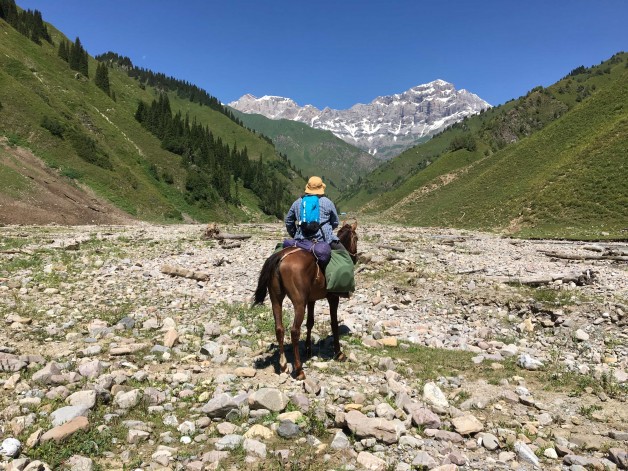
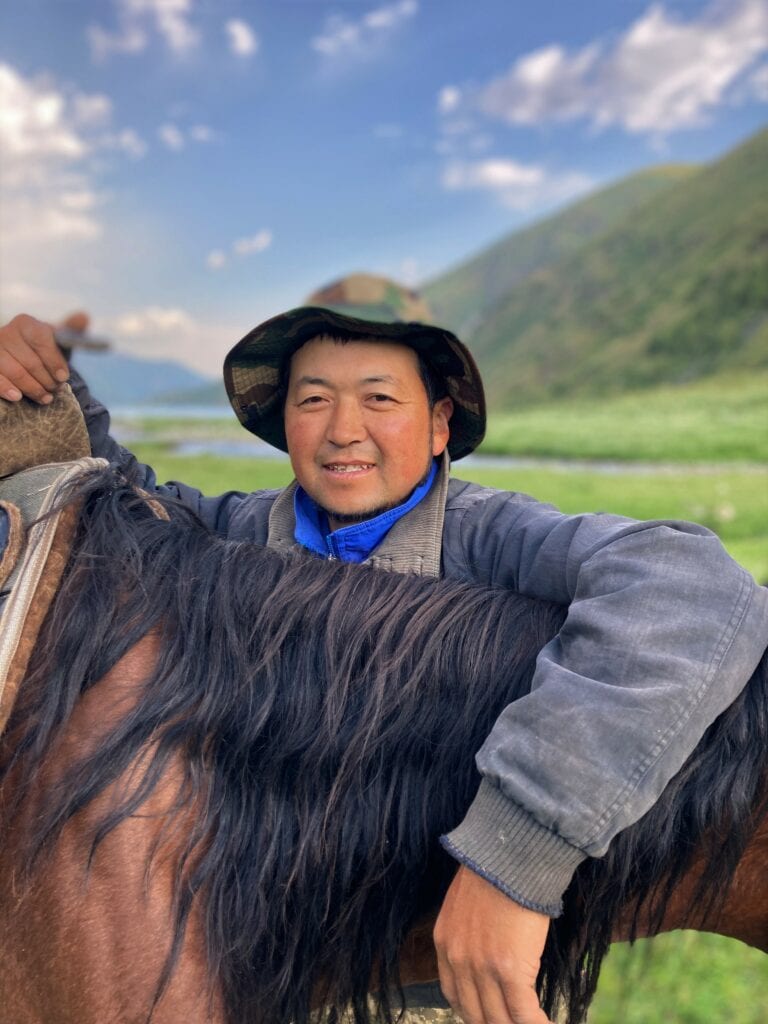

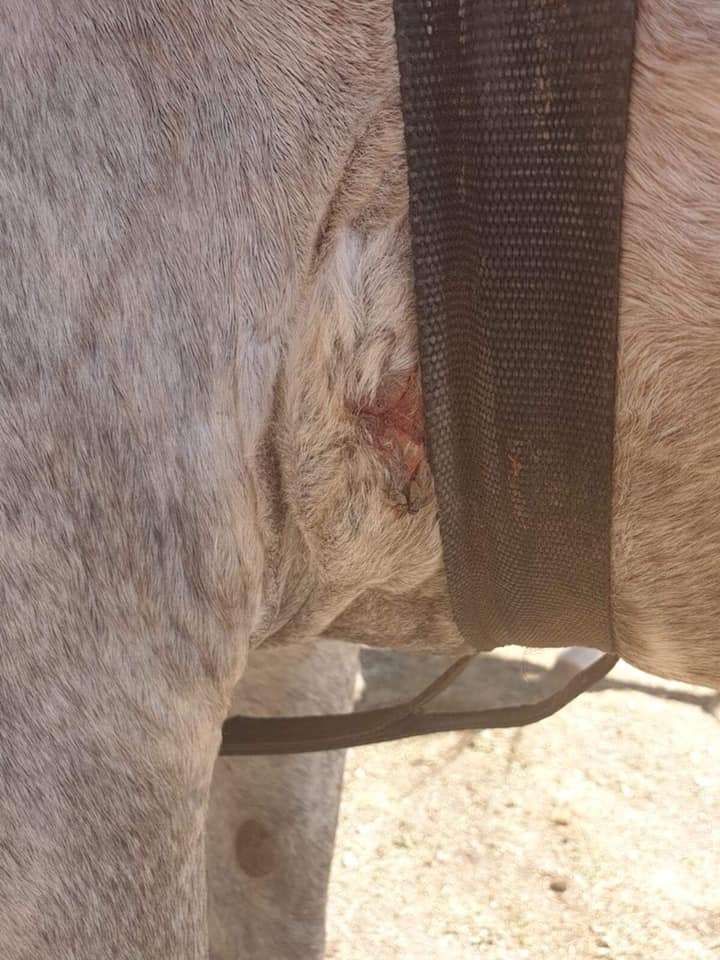
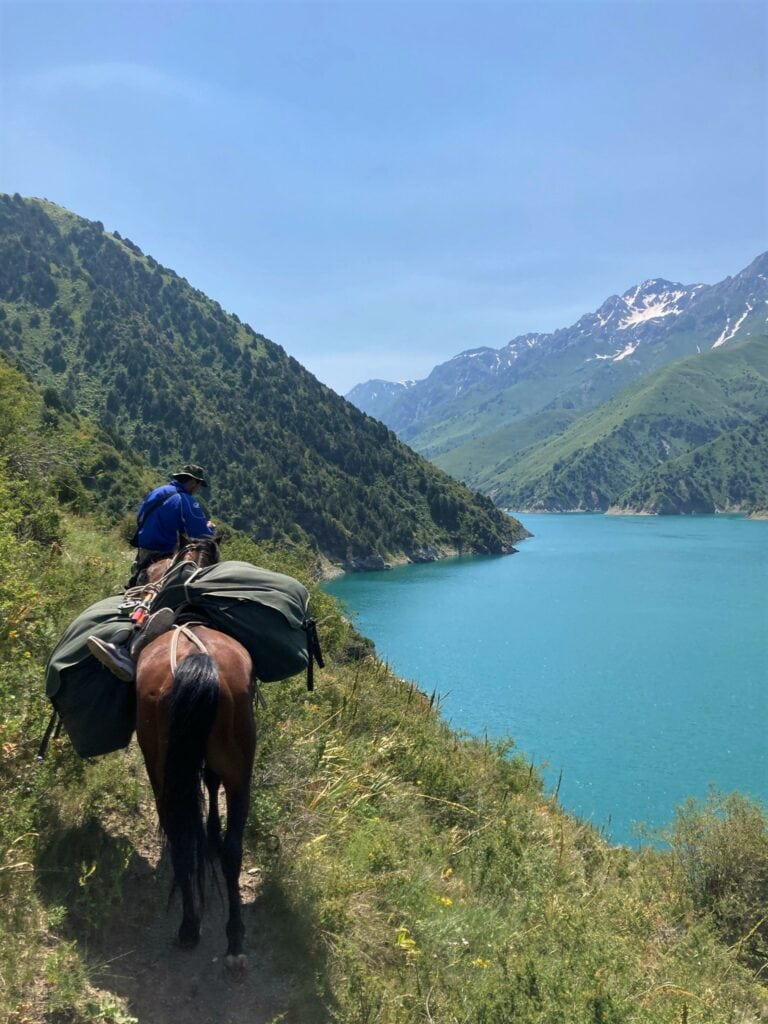
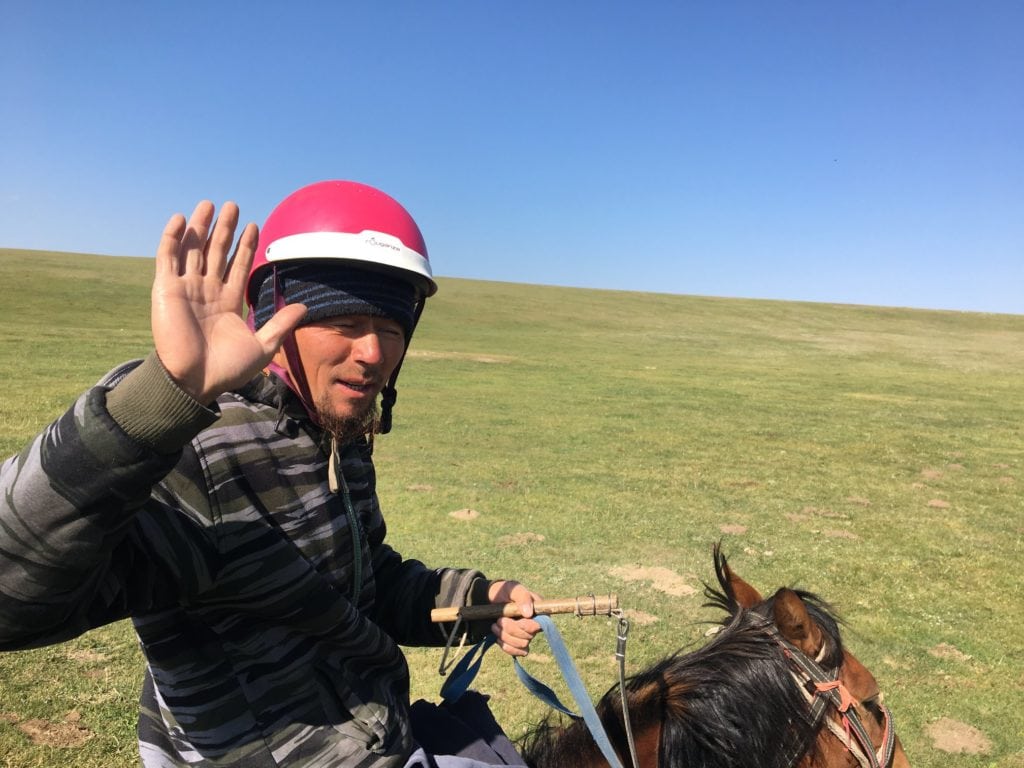
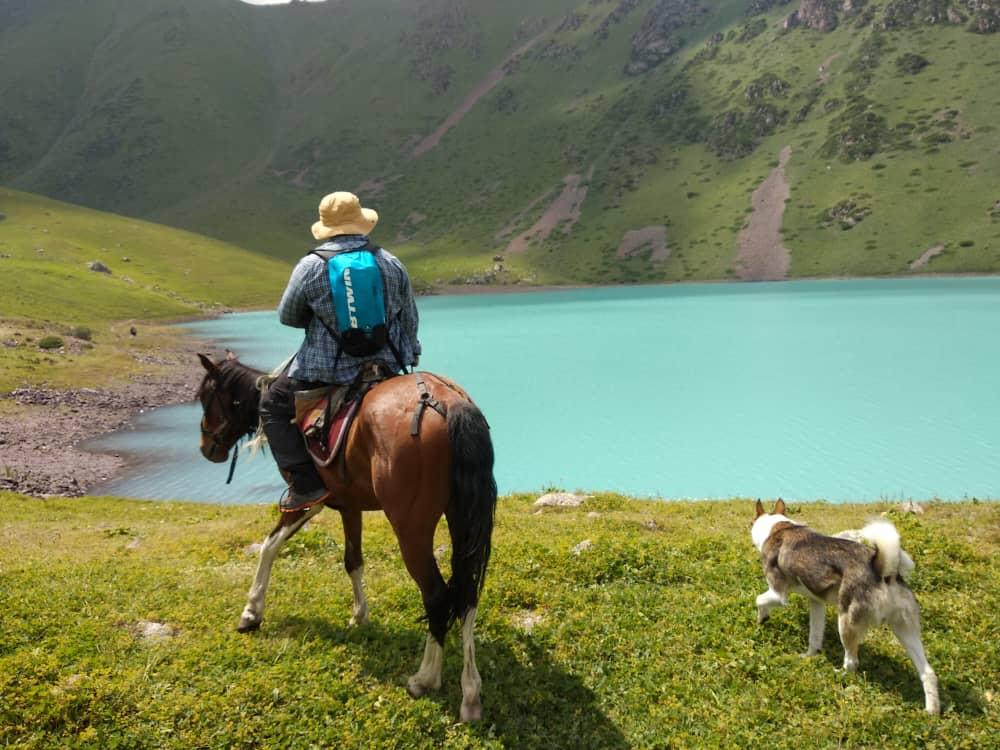
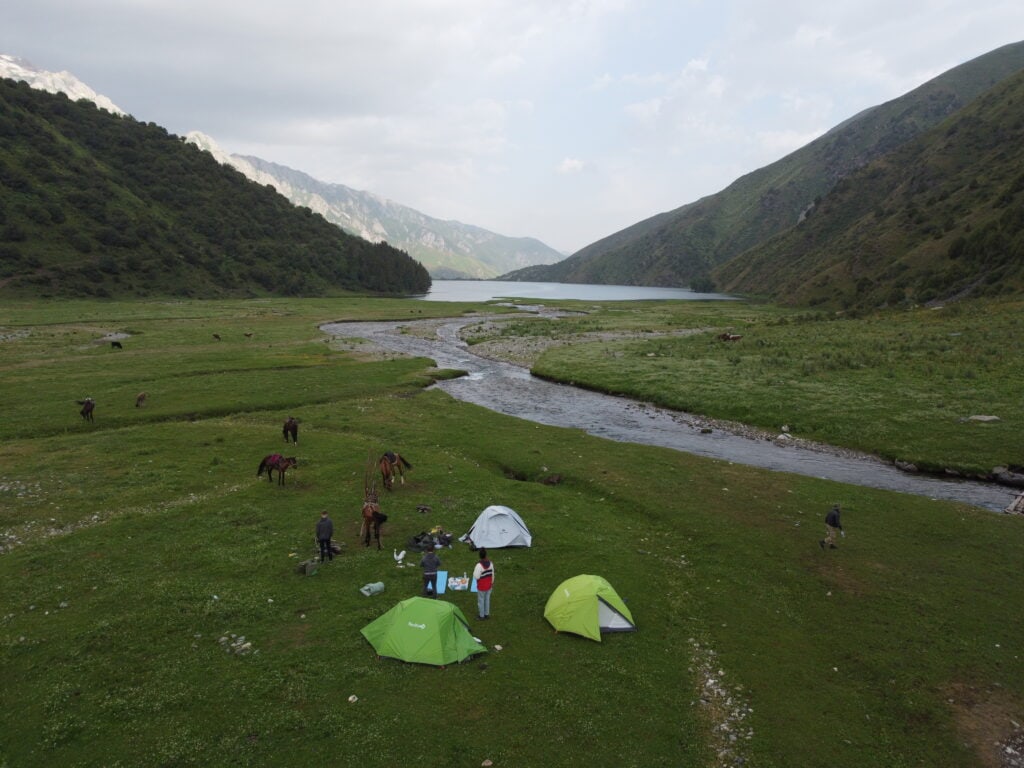
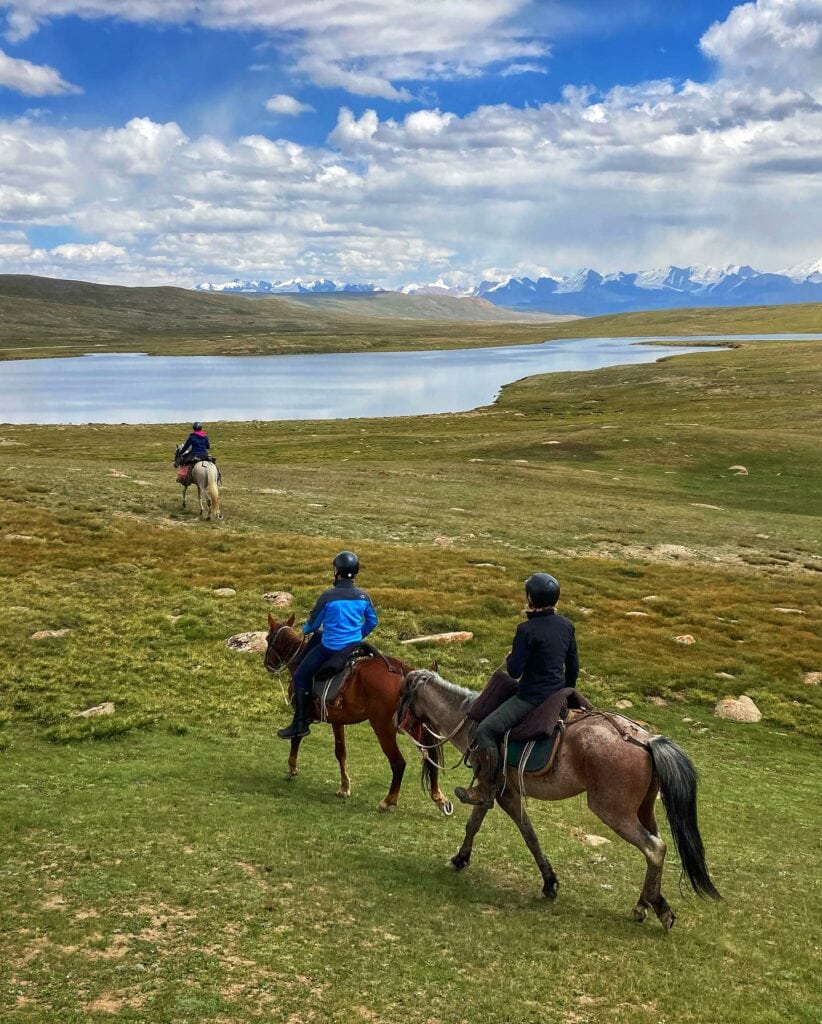

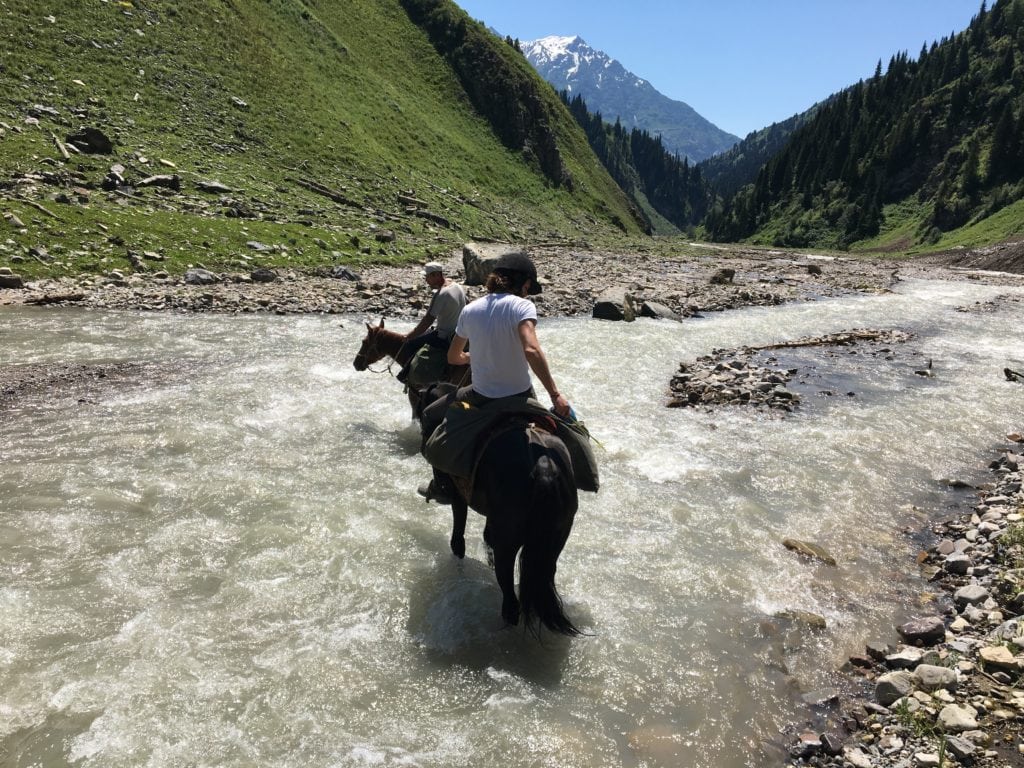

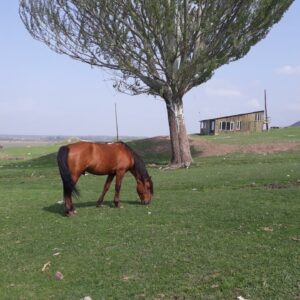
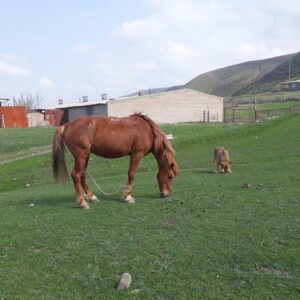

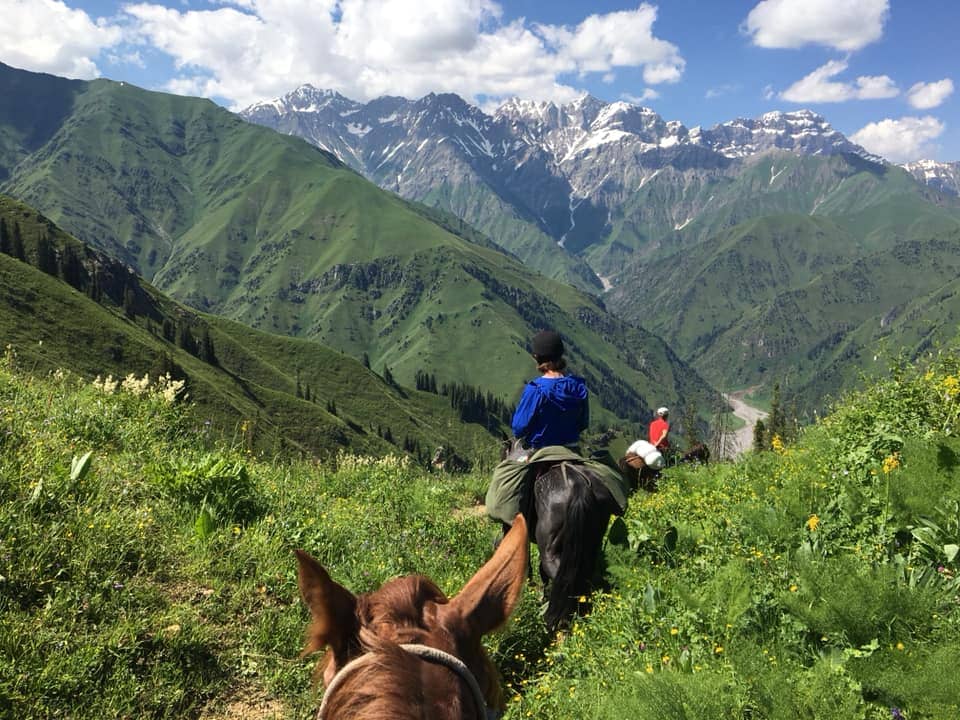
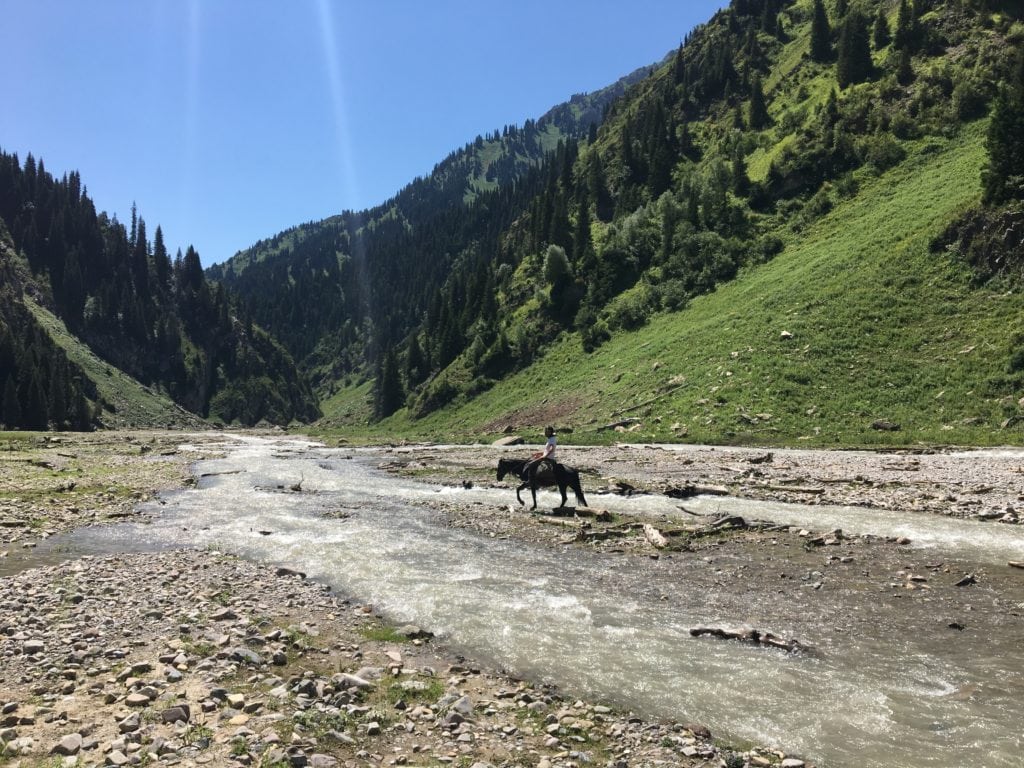
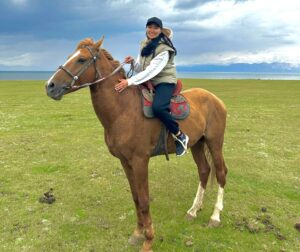
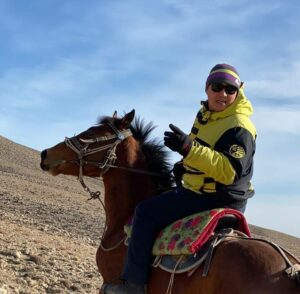



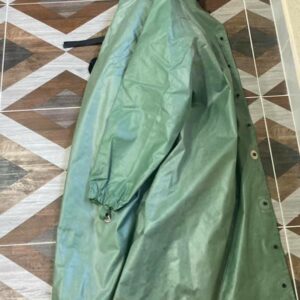

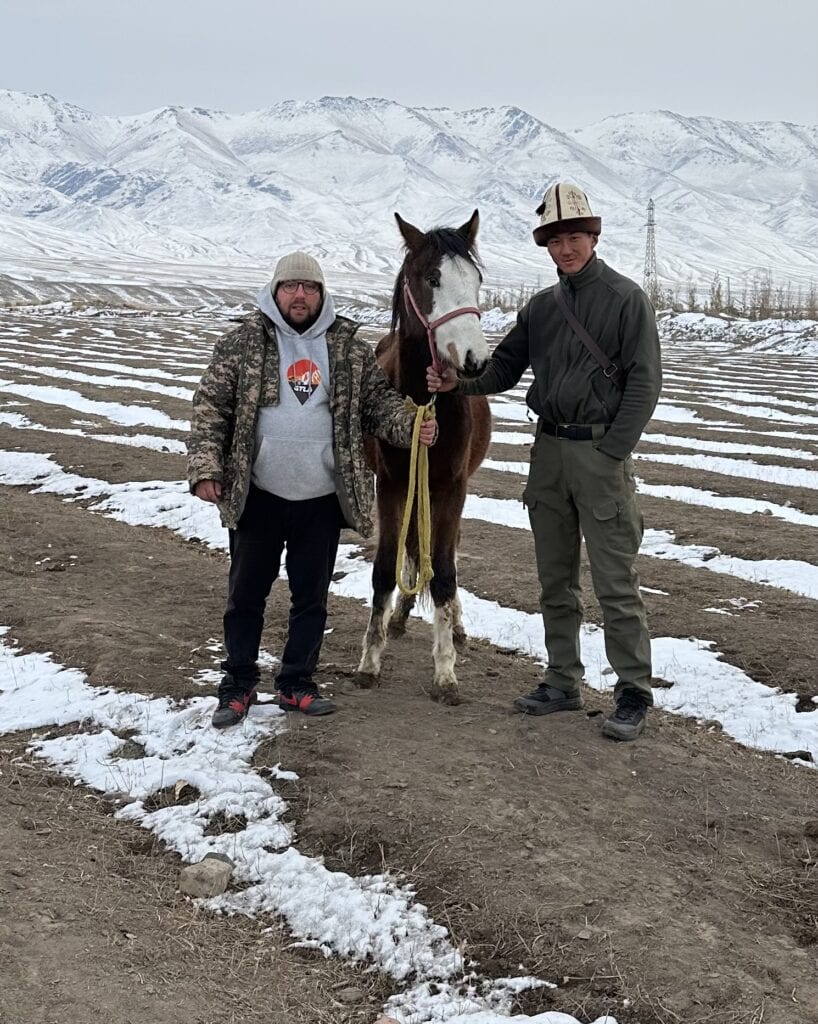

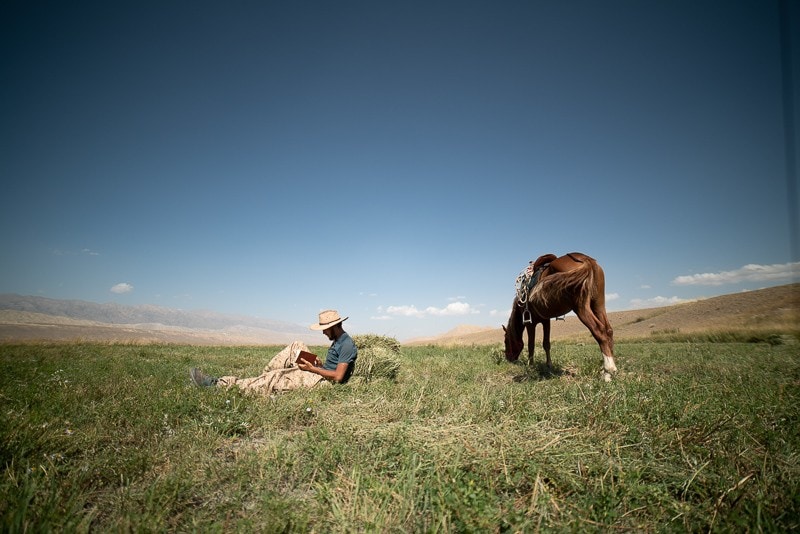
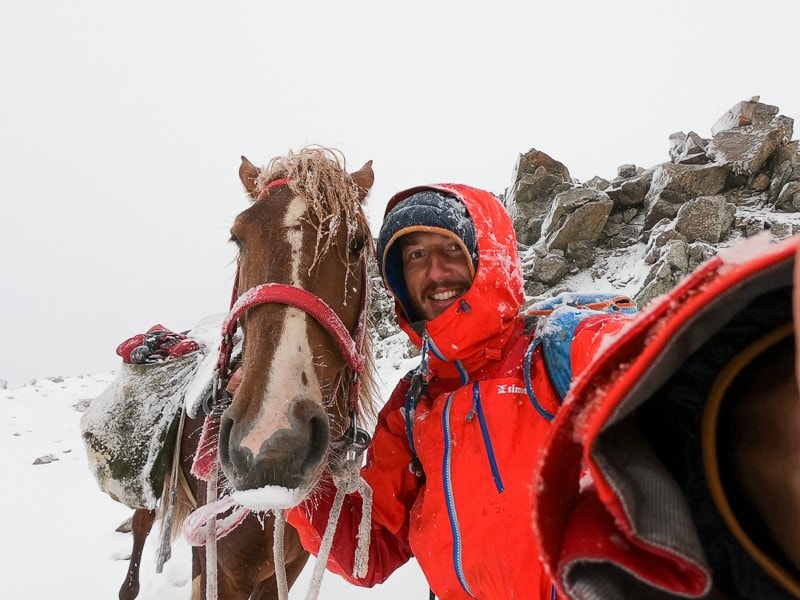
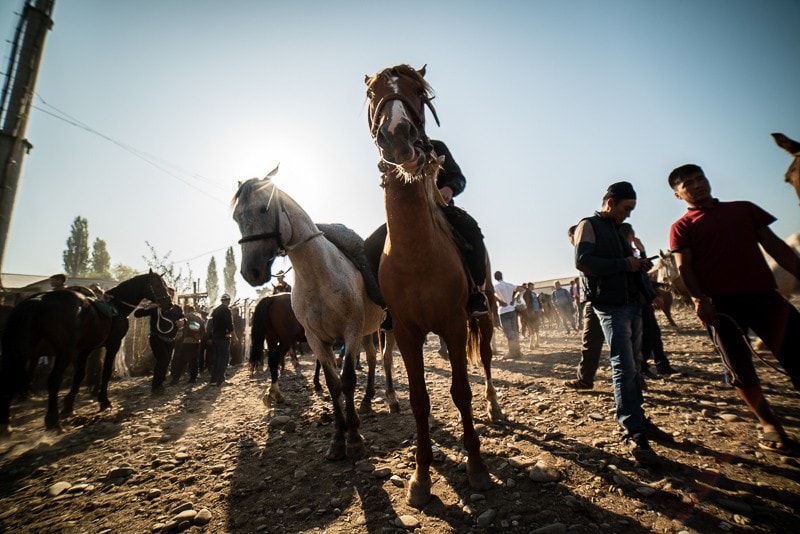
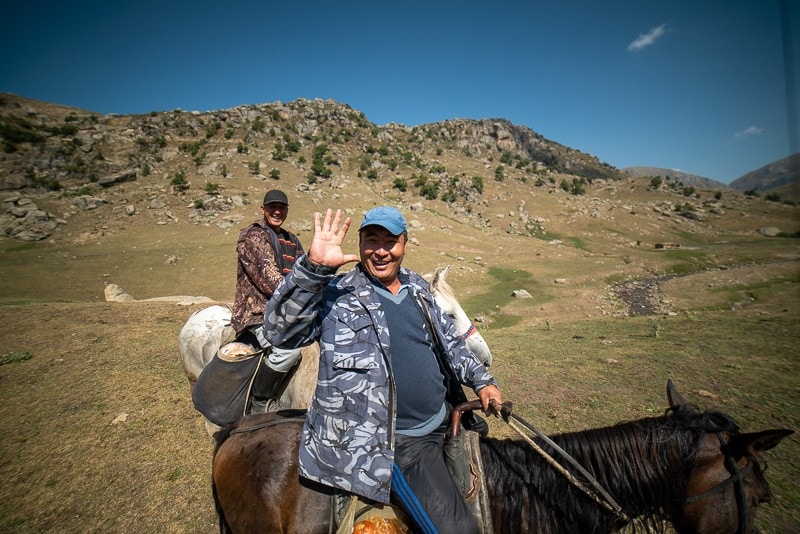

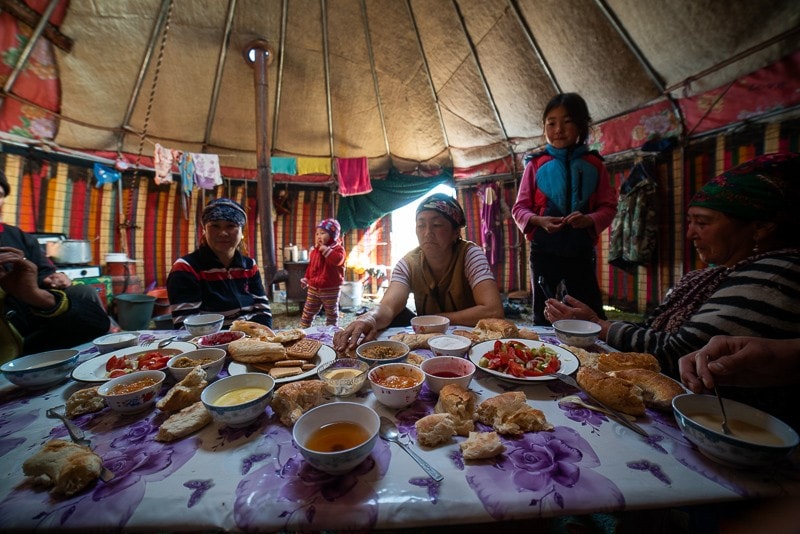
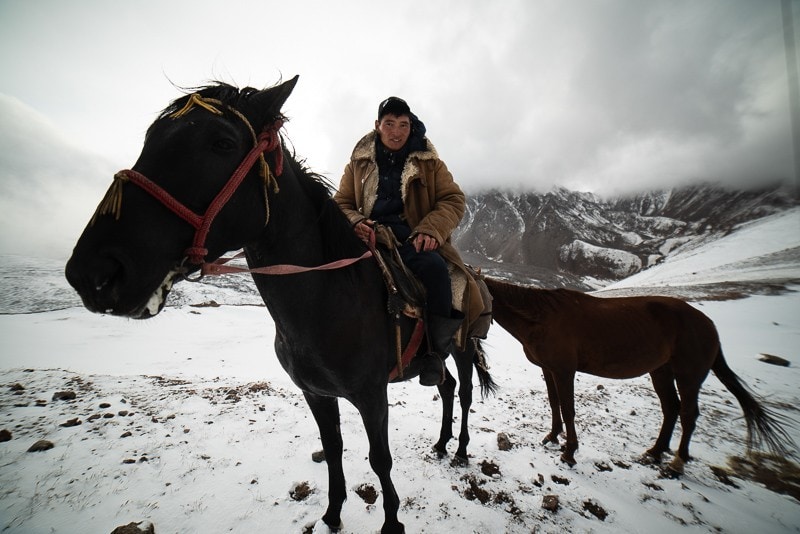
Hello, Georges, Is it possible to reach you on WhatsApp, Facebook or Instagram, to get more information about horseback riding in Kyrgyzstan?
Hello, thank you both for sharing your experiences and taking the time to tell your story.
Would you have any addresses for
Sleeping bag and tent please?
Thanks for the help
Morgane